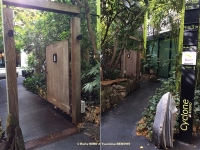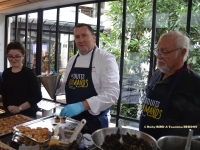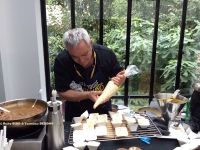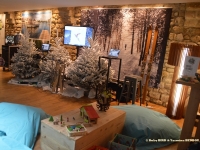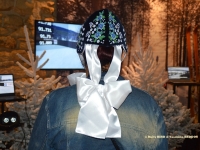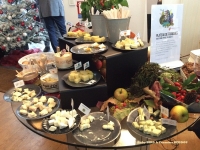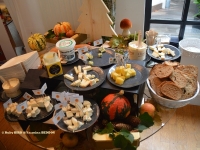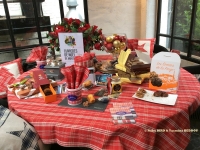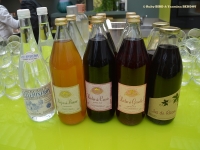Travel
LA BOURGOGNE-FRANCHE-COMTE A Votre Rythme
The Merge of 3 ADMINISTRATIVE REGIONS
Presentation / Workshops Bourgogne-Franche-Comte (Source: © Ruby BIRD & Yasmina BEDDOU)
USPA NEWS -
Bourgogne-Franche-Comté is the Official Name of one of the New Regions of France which was formed by merging the Two Former Administrative Regions of Burgundy (Bourgogne), and Franche-Comté, during the restructuring of France´s Regions in January 2016. The Regional Capital is Dijon. The Merger represents a Historic Reunification of the Duchy of Burgundy (Duché de Bourgogne) and the Free County of Burgundy (Franche Comté de Bourgogne), for the First Time since they were divided in 1477.... Bourgogne-Franche-Comté comprises Eight Departments: Côte-d'Or, Doubs, Jura, Nièvre, Haute-Saône, Saône-et-Loire, Yonne, Territoire de Belfort....
Bourgogne-Franche-Comté is the Official Name of one of the New Regions of France which was formed by merging the Two Former Administrative Regions of Burgundy (Bourgogne), and Franche-Comté, during the restructuring of France´s Regions in January 2016. The Regional Capital is Dijon. The Merger represents a Historic Reunification of the Duchy of Burgundy (Duché de Bourgogne) and the Free County of Burgundy (Franche Comté de Bourgogne), for the First Time since they were divided in 1477.... Bourgogne-Franche-Comté comprises Eight Departments: Côte-d'Or, Doubs, Jura, Nièvre, Haute-Saône, Saône-et-Loire, Yonne, Territoire de Belfort. The Major Communities are : Dijon, Besançon, Belfort, Chalon-Sur-Saône, Nevers, Auxerre, Macôn.
Burgundy (Bourgogne) is a Historical Territory and a Former Administrative Region of East-Central France. It takes its Name from the Burgundians, an East Germanic People who moved Westwards beyond the Rhine during the late Roman period. Historically, "Burgundy" has referred to numerous Political Entities, including Kingdoms and Duchies. Since January 2016, the name Burgundy has referred to a Specific Part of the French Administrative Region of Bourgogne-Franche-Comté, an Entity comprising Four Departments: Côte-d'Or, Saône-et-Loire, Yonne, and Nièvree.
Burgundy is one of France's main Wine Producing Areas. It is well known for both its Red and White Wines, mostly made from Pinot Noir and Chardonnay Grapes, respectively, although other Grape Varieties can be found, including Gamay, Aligote, Pinot Blanc, and Sauvignon Blanc. The Region is divided into the Côte-d'Or, where the most Expensive and Prized Burgundies are found, and Beaujolais, Chablis, the Côte Chalonnaise and Mâcon. The Reputation and Quality of the Top Wines, together with the fact that they are often produced in Small Quantities, has led to High Demand and High Prices, with some Burgundies ranking among the most Expensive Wines in the World.... With regard to Cuisine, the Region is Famous for the Burgundian Dishes Coq Au Vin, Beef bourguignon, and Epoisses De Bourgogne Cheese.
Burgundy lies astride the main Lines of Communication between Paris and Lyon, and anyone travelling by Train or on the French Motorway Network between Paris or North-East France, and Lyon and the South of France, must pass through it. The Area and Former Region is bordered by the River Loire, in the West, and by the Franche-Comté and Champagne Areas in the East. To the South it is bordered by the Rhone Alpes Region.... The Historic and Modern Capital of the Burgundy Region is Dijon, a Thriving Administrative and Cultural Centre, which is also a Major Communications and Freight-Distribution Hub. The City is just 1hr. 40 mins. from Paris by Direct TGV High-Speed Train Service. Dijon has a Historic City Centre, with Old Narrow Streets, and Houses built in the Local Pale Honey-Coloured Stone; of particular interest to Visitors are the Palace of the Dukes of Burgundy, and the Gothic Cathedral of Saint Bénigne. The Centre of Old Dijon is classed as a UNESCO World Heritage Site.
Franche-Comté is a Cultural and Historical Region of Eastern France. It is composed of the Modern Departments of Doubs, Jura, Haute-Saône and the Territoire de Belfort. From 1956 to 2015, the Franche-Comté was a French Administrative Region. Since 1 January 2016, it has been part of the New Region Bourgogne-Franche-Comté. The Region is named after the Franche Comté de Bourgogne (Free County of Burgundy), definitively separated from the Region of Burgundy Proper in the Fifteenth Century. In 2016, these Two Halves of the Historic Kingdom of Burgundy were reunited, as the Region of Bourgogne-Franche-Comté. It is also the 6th Biggest Region in France. The Principal Cities are the Capital Besançon, Belfort and Montbéliard (the Last Two form the Aire Urbaine Belfort-Montbéliard-Héricourt-Delle). Other Important Cities are Dole (the Capital before the Region was conquered by Louis XIV in the Late Seventeenth Century), Vesoul (Capital of Haute-Saône), Arbois (The "Wine Capital" of The Jura), and Lons-le-Saunier (The Capital of Jura).
The Name Franche Comté de Bourgogne (Free County of Burgundy) did not appear Officially until 1366. It had been a Territory of the County of Burgundy from 888, the Province becoming Subject to the Holy Roman Empire in 1034. It was definitively separated from the Neighboring Duchy of Burgundy upon the Latter's Incorporation into the Kingdom of France in 1477... The Franche-Comté was one of the Last Parts of France to have Serfdom.... Around 40% of the Region's GDP is dependent on Manufacturing Activities, and most of its Production is exported. Construction of Automobiles and their Parts is one of the most Buoyant Industries there. Forestry Exploitation is Steadily Growing, and a Good part of the Agriculture is Dairy and Cattle Farming. The Region has a Large and Lucrative Cheese-Making Industry, with 40 million Tonnes of Cheese produced here Each Year, much of which is made by Fruitières (Traditional Cheese Dairies of Franche-Comté); for instance, Comté Cheese comes from this Region.
This Region borders Switzerland and shares much of its Architecture, Cuisine, and Culture with its Neighbour. Between the Vosges range of Mountains to the North and the Jura range to the South, the Landscape consists of rolling Cultivated Fields, Dense Pine Forest, and Rampart-Like Mountains. Not so majestic as the Alps, the Jura Mountains are more accessible and are France's First Cross-Country Skiing Area. It is also a Superb Place to Hike, and there are some Fine Nature Trails on the more Gentle Slopes. The Doubs and Loue Valleys, with their Timbered Houses perched on Stilts in the River, and the High Valley of Ain, are Popular Visitor Areas. The Région des Lacs is a Land of Gorges and Waterfalls dotted with Tiny Villages, each with a Domed Belfry Decorated with Mosaic of Tiles or Slates or Beaten from Metal. The Lakes are perfect for Swimming in the Warmer Months. The Summits of Haut Jura have Wonderful Views across Lac Léman (Lake Geneva) and toward the Alps.
What To VISIT & Where To GO in The REGION BOURGOGNE-FRANCHE-COMTE :
* Le Plateau Des 1 000 Etangs in Haute-Saône, The Seven Waterfalls of Hérisson in Jura, Le Mont Beuvray, Le Mont d´Or, La Roche De Solutré, Le Saut Du Doubs, Lakes of Chalain, Vouglans, Saint-Point, Du Malsaucy, Des Settons, De Pannecière, De Chaumeçon...
* Well-Being Destinations : The SPAS of : Luxeuil-les-Bains (70), Bourbon-Lancy (71), Salins-les-Bains, Lons-le-Saunier (39) et Saint-Honoré-les-Bains (58).
* An Architectural Heritage To Visit : Hospices De Beaune, Châteaux De Guédelon, Du Clos De Vougeot, De Châteauneuf-En-Auxois, Château De Joux, Palais Des Ducs Et Des Etats at Dijon, Vestiges d´Alésia, Oppidum De Bibracte, Temple De Janus at Autun, Abbayes De Cîteaux Et Cluny¸ Chapelle Notre-Dame-Du-Haut at Ronchamp, Lion De Bartholdi at Belfort, Villages of Vézelay, Baume-les-Messieurs, Château-Chalon,....An Heritage classified by l´UNESCO : Abbaye Cistercienne De Fontenay, Basilique De Vézelay, Prieuré De La Charité-Sur-Loire, Citadelle De Besançon, Chapelle De Ronchamp, Saline Royale d´Arc-Et-Senans, Grande Saline De Salins-les-Bains,....
* Le Plateau Des 1 000 Etangs in Haute-Saône, The Seven Waterfalls of Hérisson in Jura, Le Mont Beuvray, Le Mont d´Or, La Roche De Solutré, Le Saut Du Doubs, Lakes of Chalain, Vouglans, Saint-Point, Du Malsaucy, Des Settons, De Pannecière, De Chaumeçon...
* Well-Being Destinations : The SPAS of : Luxeuil-les-Bains (70), Bourbon-Lancy (71), Salins-les-Bains, Lons-le-Saunier (39) et Saint-Honoré-les-Bains (58).
* An Architectural Heritage To Visit : Hospices De Beaune, Châteaux De Guédelon, Du Clos De Vougeot, De Châteauneuf-En-Auxois, Château De Joux, Palais Des Ducs Et Des Etats at Dijon, Vestiges d´Alésia, Oppidum De Bibracte, Temple De Janus at Autun, Abbayes De Cîteaux Et Cluny¸ Chapelle Notre-Dame-Du-Haut at Ronchamp, Lion De Bartholdi at Belfort, Villages of Vézelay, Baume-les-Messieurs, Château-Chalon,....An Heritage classified by l´UNESCO : Abbaye Cistercienne De Fontenay, Basilique De Vézelay, Prieuré De La Charité-Sur-Loire, Citadelle De Besançon, Chapelle De Ronchamp, Saline Royale d´Arc-Et-Senans, Grande Saline De Salins-les-Bains,....
* A GASTRONOMY To Taste : Le Jambon Persillé, La Saucisse De Montbéliard, La Saucisse De Morteau, Le Comté, Le Morbier, Le Vacherin Mont d´Or, La Cancoillotte, L´Epoisses, Le Bleu De Gex, Snails, Mustard, Le Pain d´Epices, L´Anis de Flavigny, Les griottines, La truffe, Les morilles, Le cassis, L´absinthe“¦ The Land of Great Wines from Chablis to Saint-Véran, from Beaun to Gevrey-Chambertin, passing by Mercurey, the Burgundy Area has an International Wine Reputation (33 Classified Grand Cru). 100 Appellations d´Origine Contrôlée (AOC) The Jura Vineyards extend on around 1,850 Hectares with 4 AOC Areas (Arbois, Côtes Du Jura, Château-Chalon, L´Etoile), 2 AOC Products (Macvin Du Jura, Crémant du Jura), 2 Traditional Distinctions (Le Vin Jaune & Le Vin De Paille) & 5 Cépages, Chardonnay & Pinot, but also Savagnin, Poulsard & Trousseau....
Source : Studio Cyclone in Paris, on October 17, 2019. Presentation by The Office Du Tourisme La Bourgogne-Franche-Comté
Ruby BIRD
http://www.portfolio.uspa24.com/
Yasmina BEDDOU
http://www.yasmina-beddou.uspa24.com/
Source : Studio Cyclone in Paris, on October 17, 2019. Presentation by The Office Du Tourisme La Bourgogne-Franche-Comté
Ruby BIRD
http://www.portfolio.uspa24.com/
Yasmina BEDDOU
http://www.yasmina-beddou.uspa24.com/
Ruby Bird Yasmina Beddou Dijon Franche Comte Burgundy Administrative Regions Tourism Business Gastronomy Patrimony Innovation Attractivity France
Liability for this article lies with the author, who also holds the copyright. Editorial content from USPA may be quoted on other websites as long as the quote comprises no more than 5% of the entire text, is marked as such and the source is named (via hyperlink).

